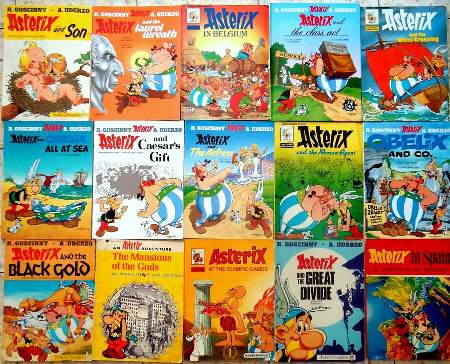
Sometimes people do things that seem a bit odd but fun!
In 2011 a fun study with a serious side about traumatic brain injury was conducted by a group of Neurosurgeons in Germany.
The results were published in the European Association of Neurobiological Studies and widely reported since.
Why is that special you might ask?
Well this experiment looked at the incidence, severity and treatment of traumatic brain injury in the Asterix comic series! Cartoon characters acquiring brain injury.
Who or What Are Asterix Comics
For those of you who might have missed Asterix comics -I might have if not for a son devoted to them. Including wanting me to cook wild boar in cream sauce! In Australia.
This is a series of comics first published in 1959. Set in ancient Rome in 50BC. The main characters are Asterix and his close friend Obelix, fictional soldiers protecting their village of Gaul from the Roman army. Only 34 volumes were produced.
How Did The Researchers Study Traumatic Brain Injury in Asterix Comics?
Firstly I think one has to remember two things – this was fun, and no external funding was used.
The group reviewed 32 Asterix comics stating they performed a “systematic retrospective analysis” of traumatic brain injury to “evaluate the specific risk factors and outcomes of traumatic brain injury in Asterix”.
Neurological examination was undertaken and the level of consciousness was assessed using the Glasgow Coma Scale
What Were the Findings of the Study of Traumatic Brain Injury in Asterix Comics?

Incidence of Traumatic Brain Injury Identified:
704 incidence of head or brain injury were identified. A large number sustained multiple brain injuries over subsequent comics.
99.1% were males (with only 6 females identified)
98.8% of brain injuries were caused by blunt trauma
98% of brain injuries were caused by assaults with a few caused by falls.
Signs and Symptoms of Traumatic Brain Injury Identified:
The most common symptom was a change in the level of consciousness –
55.4% were deemed to have severe traumatic brain injury
12.6% moderate injury
31% from no change in consciousness to a mild traumatic brain injury
Other symptoms included:
Disorientation
Unusual symptoms were identified such as:
An “outstretched and sideway pointing tongue” was a common outcome
“Racoon Eyes” was also identified as a sign of a skull fracture and traumatic brain injury
There were no instances of death or permanent neurological damage.
What Treatment Did the Study of Traumatic Brain Injury in Asterix Comics Identify?

The primary treatment was a “magic potion” – a concoction containing mistletoe which was taken before battle to give superhuman powers. After battle it was given to quickly resolve symptoms.
Not the use we generally associate mistletoe with!
The study also refers to early historic documents that refer to a range of treatments. For example Hippocrates described a procedure similar to what is used today to relieve pressure caused by a fracture – the removal of a piece of skull.
The Edwin Smith Paypyrus from ancient Egypt refers to a range of treatments used when wounds were not open, and there were no depressed fractures of the skull.
Why Was the Study of Traumatic Brain Injury in Asterix Comics Undertaken?
The authors assure readers that the research was conducted in their own time and no external funds were used!
The study was not altogether serious. The actual reason is not 100% clear from my reading. Maybe it was a love of Asterix and Obelix and their adventures!
What is apparent is that by using humour and fun the article –
- promotes the use of helmets
- helps understanding of brain injury
- highlights groups commonly at risk of traumatic brain injury – groups that are reflected in todays world including:
- males
- people who belong to minority groups
- traumatic brain injury in soldiers.
The Serious Side: What Could Be Learned About Traumatic Brain Injury In Asterix Comics?

Appropriate Helmets Correctly Worn can Reduce Incidence of Brain Injury
The authors highlight the use of helmets to reduce brain injury citing other more recent studies beyond Asterix comics that show a reduction in brain injury if helmets are worn.
It was noted the design of helmets in Asterix comics were less than ideal. They unfortunately fell off easily reducing the effectiveness, and helmets were rarely secured appropriately.
Ethnicity and Gender Are Risk Factors in Ancient Rome and our Modern World
It was found that gender and ethnicity played a part in the incidence of brain injury.
The authors completed an audit of the ethnicity of those sustaining brain injury and found some groups more prone to injury than others.
More recent studies support these findings showing for instance that males are more at risk. Studies of black populations (e.g. United States and South Africa) were more likely to sustain traumatic brain injury than the white population.
It was also noted that a smaller number of females sustained injury again echoed in figures today
There is an Increased Risk of Traumatic Brain Injury for Soldiers Then and Now
This is a topic covered previously here. Again this article reinforces the increased risk of traumatic brain injury in soldiers. See also Misdiagnosed and Undiagnosed
Asterix Comics Can Promote Discussion of Brain Injury
There have been numerous articles, blogs, websites, and popular news sites across the world that have shared this study. This suggests that it has been a useful way to promote discussion of brain injury.
More About The Study of Traumatic Brain Injury in Asterix Comics?
The authors of the study are neurosurgeons Marcel A. Kamp, Philipp Slotty, Sevgi Sarikaya-Seiwert, Hans-Jakob Steiger, Daniel Hänggi. The full article is printed in Acta Neurochirurgica ISSN: 0001-6268 (Print) 0942-0940 (Online) June 2011, Volume 153, Issue 6, pp 1351-1355 Date: 07 Apr 2011 (see below for a link to an abstract and the full article).
You can read the ABSTRACT: Traumatic brain injuries in illustrated literature: experience from a series of over 700 head injuries in the Asterix comic books
OR
The full study HERE
And Finally
What are your thoughts?
Fun way to learn about brain injury. Waste of time. What were they thinking. Good on them. What springs to mind?

